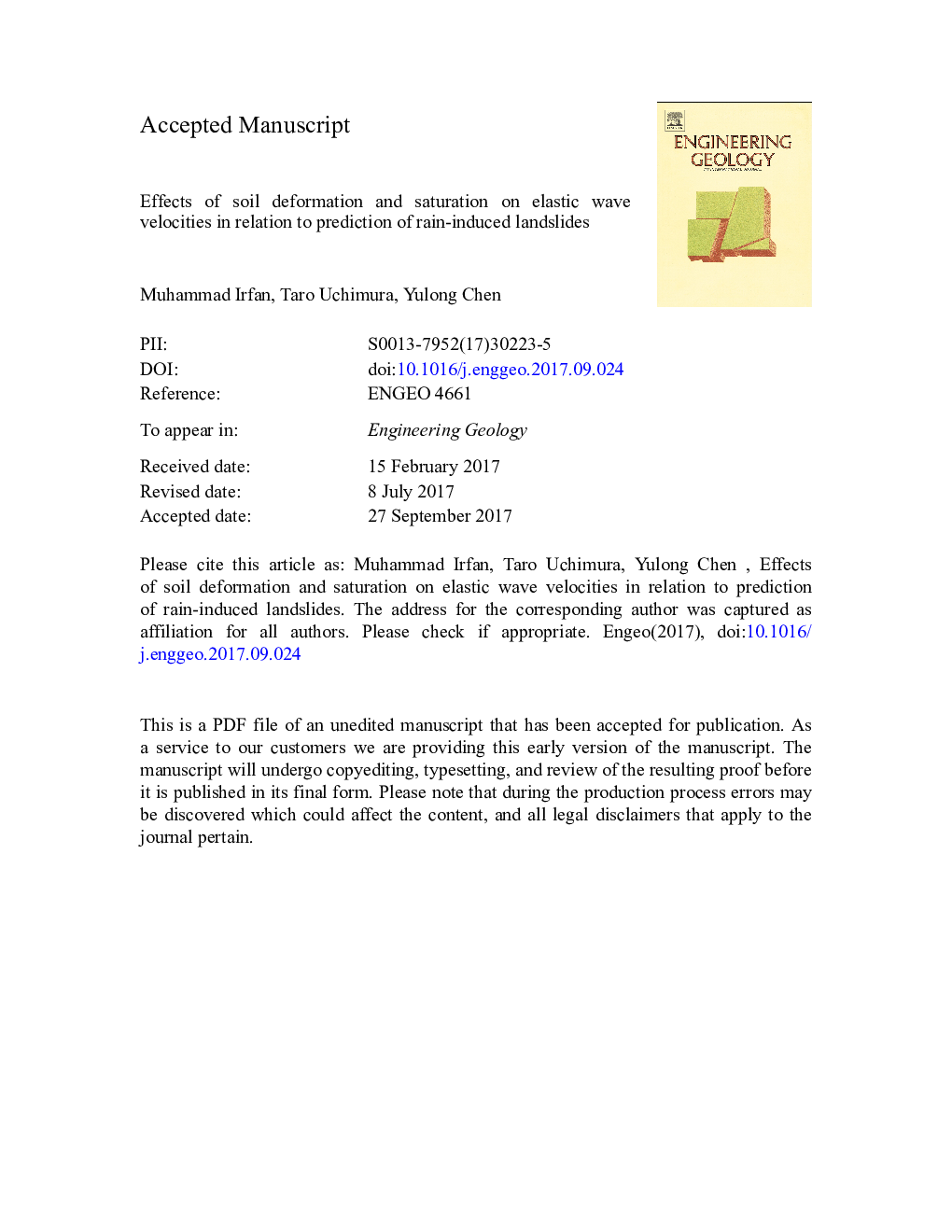| کد مقاله | کد نشریه | سال انتشار | مقاله انگلیسی | نسخه تمام متن |
|---|---|---|---|---|
| 5787428 | 1641755 | 2017 | 49 صفحه PDF | دانلود رایگان |
عنوان انگلیسی مقاله ISI
Effects of soil deformation and saturation on elastic wave velocities in relation to prediction of rain-induced landslides
ترجمه فارسی عنوان
اثرات تغییر شکل خاک و اشباع بر سرعت موج کششی در مقایسه با پیش بینی زمینی لغزش ناشی از باران
دانلود مقاله + سفارش ترجمه
دانلود مقاله ISI انگلیسی
رایگان برای ایرانیان
کلمات کلیدی
رانش زمین، هشدار زودهنگام، پخش امواج، سرعت موج برشی، سرعت موج فشرده سازی، تزریق آب
ترجمه چکیده
ابزار فعلی سیستم های هشدار دهنده زود هنگام فرسایش فیزیکی از سنسورهای رطوبت یا سنسورهای تغییر شکل شیب استفاده می کنند. تمام سنسورهای این سنسور نقطه هستند و تنها در تغییر مجدد پارامترهای فیزیکی حساس هستند. بنابراین تعداد زیادی سنسورها برای پوشش یک منطقه بالقوه لغزش زمین مورد نیاز هستند. در این مقاله ایده ای برای مشاهده تغییرات رطوبتی خاک و تغییر شکل در سطح شیب با استفاده از انتشار موج موج در خاک پیشنهاد شده است. دو بخش از آزمایشات سه گانه به عنوان بخشی از این مطالعه انجام شد. اولین سری از آزمایشات رفتار رفت و برگشت موج الاستیک را با رطوبت مختلف خاک بررسی کرد. در یک سری آزمایش دیگر، نمونه های خاک تحت تاثیر استرس های میدان تحت تاثیر عناصر خاک در هنگام رانندگی ناشی از باران قرار گرفتند. پاسخ سرعت سرعت الاستیک در حوادث رانندگی ناشی از بارندگی در این سری آزمایش ها مورد بررسی قرار گرفت. کشف شد که هر دو سرعت برشی و سرعت فشرده سازی تقریبا نیمی از زمانیکه اشباع خاک از 20 درصد به 80 درصد افزایش می یابد، کاهش می یابد. از آزمایشات مسیر استرس میدان، دو مرحله مجزا از شکست شیب ناشی از باران شناسایی شد. تغییرات زیادی در رطوبت خاک در مرحله اول شکست رخ داد و تغییرات خاک بسیار کم بود. در حالی که در مرحله دوم شکست، تغییرات زیادی رخ داده است، با افزایش بسیار زیاد در رطوبت خاک. هر دو سرعت برشی و سرعت فشرده سازی به تدریج در فاز اولیه کاهش می یابد، در حالی که کاهش سریع در مرحله دوم شکست رخ می دهد. با مشاهده تغییر در سرعت موج، زمان شروع شکست و نرخ تنش پس از شکست به طور واضح مشخص می شود. چنین تنوع مجزا سرعت موج در طی شکست شیب ناشی از باران می تواند مفید باشد در طراحی یک سیستم پیش بینی قوی زمینی.
موضوعات مرتبط
مهندسی و علوم پایه
علوم زمین و سیارات
مهندسی ژئوتکنیک و زمین شناسی مهندسی
چکیده انگلیسی
The present means of physical landslide early warning systems make use of moisture sensors or slope deformations sensors. All such sensors are point sensors and are sensitive to variation of physical parameters in the vicinity of sensors only. A large number of sensors are therefore required to cover a wide potential landslide area. An idea to observe soil moisture changes and deformations in slope surface by means of elastic wave propagation in soil is proposed in this paper. Two series of triaxial experiments were conducted as part of this study. The first series of experiments explored the behavior of elastic wave propagation with varying soil moisture. In another series of experiments, soil specimens were subjected to the field stress path experienced by soil elements during rain-induced landslides. The response of elastic wave velocities during rain-induced landslides was envisaged in this test series. It was discovered that both shear, and compression wave velocities decrease by nearly half when soil saturation was increased from 20% to ~Â 80%. From the field stress path tests, two distinct phases of rain-induced slope failures were identified. Large change in moisture content of soil was observed in the first phase of failure with the soil deformations being very small. Whereas in the second phase of failure large deformations occurred, with very small increase in moisture content of soil. Both shear, and compression wave velocities decreased gradually in the initial phase, whereas a rapid decrease was observed in the second phase of failure. By observing the change in wave velocities, time of failure initiation and post-failure strain rate could distinctly be identified. Such distinct variation of wave velocities during rain-induced slope failures can be helpful in designing a robust landslide prediction system.
ناشر
Database: Elsevier - ScienceDirect (ساینس دایرکت)
Journal: Engineering Geology - Volume 230, 29 November 2017, Pages 84-94
Journal: Engineering Geology - Volume 230, 29 November 2017, Pages 84-94
نویسندگان
Muhammad Irfan, Taro Uchimura, Yulong Chen,
